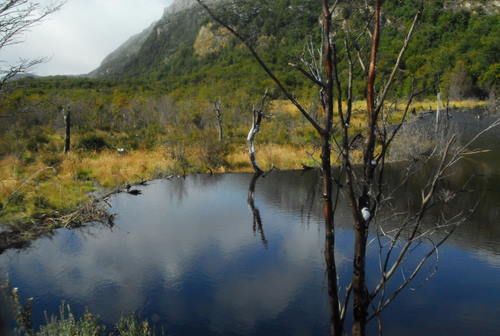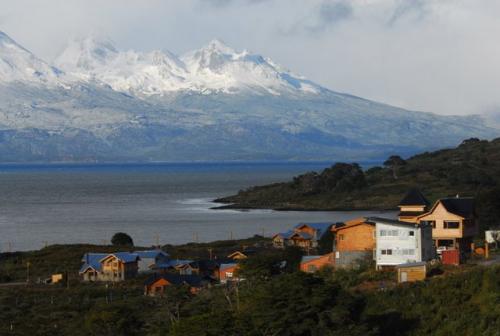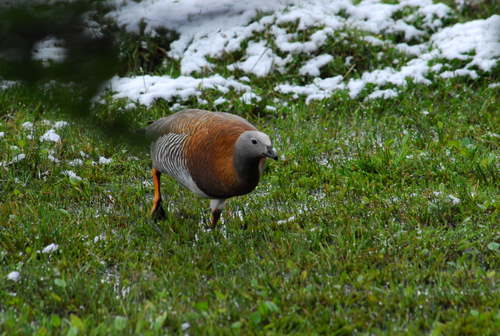At the Southern Tip of Argentina
From Manaus, Brazil I bounced my way southward via a series of short flights that took me to Sao Paulo, Brazil (the largest city in South America … and one of the largest in the world), to Buenos Aires and eventually to Ushuaia, Argentina, the most southerly city on the planet. I was flying from the hot, humid Amazon basin to the cold and snow of Tierra del Fuego. As the plane banked to position itself to make a straight path to the Ushuaia airport runway I got a glimpse of the rugged mountains that surround the city and the fresh blanket of snow that covered the peaks.
Near Ushuaia, Tierra del Fuego, Argentina
I was in Ushuaia to join a small ship heading to the Antarctic Peninsula as this southern-most city is the jump off point for many expedition trips heading to the ice, penguins and marine mammals of Antarctica.
Prior to embarking on my Antarctic adventure, I had the opportunity to visit Tierra del Fuego National Park a beautiful protected area to the west of Ushuaia, right on the border with Chile.
In Spanish, Tierra del Fuego means ‘land of fire’ and although you people might think that it got its name from volcanoes on the island, there are in fact no volcanoes on Tierra del Fuego.
Depending on who you believe the name was given to the island by early explorers to the region either because they saw the smoke from fires used by the area’s aboriginal people (who used fire for cooking and to keep warm) or because of the misty haze that frequently hovers over the island and along its coastlines.
Tierra del Fuego is a group of islands (with one large island which the National Park is located on) and it is also very far south. Both of these factors contribute to the low number of wildlife species in the National Park. There are only 20 species of mammals and about 90 species of birds found in the park.
Ashy-Headed Goose, Tierra del Fuego National Park, Argentina
There is though one introduced mammal species that is causing havoc in the park and in the region in general, and that is the North American Beaver (Castor canadensis). Beavers were brought to Tierra del Fuego by the Argentinean government in an attempt to provide animals for the fur industry. Initially the beavers were in enclosed fur farms. But, the endeavour failed as there were no facilities to process the pelts and there was no market for the furs. The beavers were then released into the wild and from an initial population of about 50 they have increased rapidly to over 100,000!
 Huge Beaver Dam, Tierra del Fuego National Park, Argentina
Huge Beaver Dam, Tierra del Fuego National Park, Argentina If you visit the park you can see the huge dams created by the beavers. One of the problems of course is that there are no predators to effectively control the number of beavers on the island and in the park. As a result the number of Beavers continues to increase along with their impacts (cutting of trees, damming of rivers and consequent flooding issues).
The management of invasive or non-native species of plants and wildlife has been a problem for natural resource managers for decades. In British Columbia we have hundreds of non-native plant species that require management action: Himalayan blackberry, Scotch broom, purple loosestrife to name a few. (For a site that looks specifically at invasive plants in BC check out:
http://www.agf.gov.bc.ca/cropprot/invasiveplant.htmThere are also non-native wildlife species that cause problems to natural communities of wildlife. An example of an introduced mammal in British Columbia would include the Sitka Black-tailed Deer that were introduced to the Queen Charlotte Islands (and eat a lot of young trees!). Sitka Black-tailed Deer are native to the mainland of BC but not to the Queen Charlotte Islands. Another example would be rats and Raccoons on some of the islands off of our coast where seabirds nest. Many species of seabirds lay their eggs in burrows on the ground and prior to the introduction of rats and Raccoons they had no predators to worry about. But rats and Raccoons are now having a serious impact on some seabird species on the BC coast.
 The End of the Road, Tierra del Fuego National Park, Argentina
The End of the Road, Tierra del Fuego National Park, Argentina



 Huge Beaver Dam, Tierra del Fuego National Park, Argentina
Huge Beaver Dam, Tierra del Fuego National Park, Argentina  The End of the Road, Tierra del Fuego National Park, Argentina
The End of the Road, Tierra del Fuego National Park, Argentina Funded by TEK
Funded by TEK
Hi Danny,
You and I kept missing each other between my return from Tajikistan and Pakistan last fall and your trip South - way South! So we didn't get to compare travel/naturalist stories yet and now you have more than I can imagine!
Anyway, thanks for sending the link to your Trax2, which is a great site. I am following your footsteps and, as everyone else says, the photos are deliciously good! Antarctica is on my wish list so I look forward to pix & blog. J'ai perdu ton addresse e-mail ... so do get in touch if you still have mine. If not, then maybe after the dust settles "apres ton retour a Vancouver" :-)
Hasta luego ... from Rare Species ("wide-ranging habitat, from deep wilderness to the urban jungle") ... AKA Cosmopolitan3 AKA Sue, enviroconsultant